Jane Lindskold's Blog, page 111
March 10, 2016
TT: Continuing the Cross(over) Examination
JANE: So, Alan, last week we decided to stop speculating as to why authors write in a wide variety of genres and actually ask a couple. I chose three authors I know here in New Mexico: Walter Jon Williams, John Maddox Roberts, and Pati Nagle.

Same Authors, Different Genres
Last week we took a look at how these authors got started.
When we were winding up, you asked me to ask our three authors why they ended up writing… How did you put it again?
ALAN: I said, “Could you ask them why they’ve ended up writing the kind of things that their names are (these days) most closely associated with?”
JANE: Right! That’s an amazing sentence… Anyhow, I did, and here are their replies.
I thought I’d start with Pati, since she’s currently publishing in three different genres and has a name to go with each one: “Pati Nagle” for SF/F, P.G. Nagle for historicals, and Patrice Greenwood for cozy mysteries
Pati said: “I love to read various genres, so I’ve also written in a number of genres. It’s like playing in your favorite fantasy worlds. A lot of writers start out writing derivative fiction set in the worlds of their favorite books/movies. With me it was Star Trek – I wrote a really terrible Trek novel when I was in my teens. I didn’t keep it; it wouldn’t have been publishable even with the serial numbers filed off. I realized years later that the main purpose of that ‘practice’ novel was to teach myself how to type.
“I’ve always got various ideas floating around in my brain. Which genre I write in next just depends on which one grabs me and says, ‘Write me now!’”
ALAN: That sounds like she just writes whatever the story demands of her, without really trying to force it into the “genre of the moment.” How extremely sensible. I wish more writers did that…
Since Pati mentioned that a lot of writers start out by writing “derivative fiction”, I feel that I have to ask if you ever did that?
JANE: Well, I freely admit that I had a complex story I told myself that borrowed heavily from everything I loved, whether written or from television. However, I didn’t actually write it down.
I wrote a story to fill in some of the gaps in the character backgrounds for the original animated Thundercats, to which I was seriously addicted as a counterpart to being a graduate student.
Now, back to your question…
For Walter Jon Williams, the path that would lead him to becoming an award-winning SF writer was a mixture of business and inclination. He says:
“The market for historical fiction dried up, and I couldn’t sell. Again, I was submitting across a number of genres, and it was the science fiction that sold.
“Many of my rejections during this period suggested that my writing was too weird or unconventional, so it’s lucky I ended up in SF, which is more open to such things.”
He added that SF/F appealed to him as more than a marketplace because: “It gave me license to experiment. Unless you experiment, you don’t get better, and I’m always trying to get better.”
ALAN: One of the things I like about Walter’s books is that he seldom writes the same thing twice. He even experiments within the novels that make up an ongoing series. And now we know why!
JANE: I agree…
For John Maddox Roberts, the path that would lead him to Roman mysteries was also due to a combination of his interests, combined with the ups and downs of the business climate. I quote:
“That first [SF] novel was followed by two more sf books, but the medieval novel was still out there circulating. By this time I had an agent, Eleanor Wood. Advances were low so I was looking for any work I could get. Signet Books was beginning an action-adventure line of books and the editor had had a look at my medieval book and asked Eleanor if I would be willing to write something similar, but set during the Crusades. These books were to be published at very close intervals so I would have to write them fast. I wrote the first in twelve days and turned out three more within the next few months. I had a contract for six books, but Signet was sold and the new owners abruptly shut down the Action-Adventure line.”
ALAN: But how did he end up writing the SPQR novels?
JANE: Again, the business climate played a role. John said than an element:
“…was the cyclical nature of science fiction – every few years a boom would turn into a slump. In the late 80s SF was in one of its slump periods and Eleanor asked if I had anything ‘different’ to send her. I turned up a few pages I’d started on several years before – a mystery set in ancient Rome. I wrote up a couple of chapters and an outline for the rest and Eleanor found a buyer at Avon books.
“My editor, John Douglas, was willing to take a chance on something this weird and the first of the series, SPQR, was nominated for the Edgar Award. Due to internal politics at Avon the series was badly mishandled and canceled after four books, but in the meantime they had become bestsellers in Europe, particularly Germany, and for several years I was writing primarily for German publication.”
JANE: As you and I both know, the series did eventually find a new American publisher, who brought the books out in hardcover. John noted that: “The SPQR series is now up to 16 languages and is being produced for television in Germany.”
ALAN: Oh, no! I don’t speak German!
JANE: I’m hoping they’ll subtitle it in English…
John had another comment, specifically about writing mysteries that I wanted to share.
He said: “Actually, I don’t understand the appeal of writing in a single genre. It seems limiting to me. Economically, mystery is dependable. Unlike the boom-and-bust cycle of SF and historical, the mystery market stays steady, for numerous reasons. Also, mystery is esteemed worldwide.”
ALAN: I’d never thought of that before, but he’s right. Nobody ever seems to feel ashamed or embarrassed if they are caught reading a mystery novel on the bus. That’s something you certainly can’t say about SF.
JANE: True enough. At least for me, my writing brain doesn’t seem happy without an element of the strange and unreal. On the other hand, the lines between the genres are becoming increasingly blurred. Could be that one of these days I’ll come up with a mystery story that will make both sides of the bookstore happy.


March 9, 2016
Series: Is There Another Word?
This weekend, Jim came to me and asked: “What’s the next book in the Narnia series? I mean, in the order things happen, not the order that’s printed on the books.”
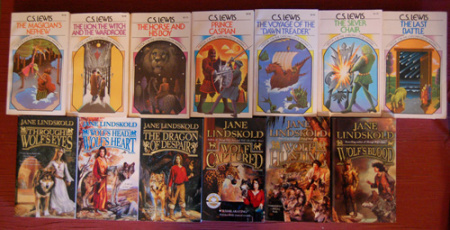
We Call Both Series…
To clarify why he was asking this, the numbers usually printed on C.S. Lewis’s classic Chronicles of Narnia are based on order of publication. They begin with The Lion, the Witch, and the Wardrobe, followed by Prince Caspian, on to The Voyage of the Dawn Treader, and so forth.
If, like Jim, you’re interested in reading the books in the order that events occur, then you want to start with The Magician’s Nephew, progress to The Lion, the Witch, and the Wardrobe, then The Horse and His Boy, and only then on to Prince Caspian, This Voyage of the Dawn Treader, The Silver Chair, and The Last Battle.
(Actually, I’d skip The Last Battle, but that’s just me.)
Anyhow, this lead to a discussion between us as to what constitutes a “series” proper and what doesn’t… Arranged by order of publication, the Chronicles of Narnia are only a “series” is the sense that this is the sequence in which the books were published.
This is very different from, for example, Roger Zelazny’s Chronicles of Amber or Carrie Vaughn’s “Kitty Norville” books or my own “Breaking the Wall” series or “Firekeeper Saga,” to give just a few examples. In these books, not only does the order of publication and the order in which events unfold occur in sequence, but the events are closely related in time and usually revolve around the same protagonist or group of protagonists.
Sometimes, as in David Weber’s “Honorverse,” one series generates another that serves to flesh out or enhance the “main” line. In Weber’s case, two of these are prequels: the “Star Kingdom” YA novels (two of which I wrote with him) and the “Manicore Ascendant” novels written with Timothy Zahn and Thomas Pope. Two other series flesh out material that wouldn’t have fit into the “main line” Honor” novels: “Crown of Slaves” with Eric Flint, and “Saganami Island” written by Weber alone.
In all of these cases, however, the books are tied either by order of events, protagonist, or both.
The Chronicles of Narnia are not alone in being widely viewed as a “series,” even though the only thing that holds the books together is that they occur in a shared setting with some overlapping characters.
Andre Norton’s ”Witch World” novels began tightly focused on just a couple of characters (Simon and Jaelithe), but quickly moved on to their children, then left them behind entirely to explore other portions of the world. When I looked up “Witch World” up on Wikipedia, I found it interesting to note that the listing there did not refer to it as a “series” at all, but as a “project,” with the books within grouped into “cycles” according to location or other elements.
However, most people don’t speak of “Witch World” as a “project,” they call it a “series.” The same is true with Marion Zimmer Bradley’s “Darkover” which not only wasn’t written in order (the first book published could be considered the last) but for which some of the earlier books were later rewritten, so that the same events could be presented in a more detailed fashion or more in line with how the characters had later developed. Talk about confusing!
So, here’s my question… Is there a term for these series that aren’t really series? And what sort do you prefer? Or do both have appeal?
March 4, 2016
FF: Like Potato Chips
It’s very strange but, although I’ve been writing a lot, I’ve also been reading a lot. I’m in one of those moods where as soon as I put down one book, I need to restrain myself from picking up another.
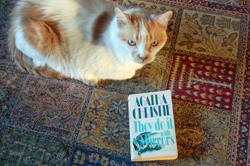
I Wonder How This Tastes?
For those of you just discovering this feature, the Friday Fragments lists what I’ve read over the past week. Most of the time I don’t include details of either short fiction (unless part of a book-length collection) or magazine articles.
The Fragments are not meant to be a recommendation list. If you’re interested in a not-at-all-inclusive recommendation list, you can look on my website under Neat Stuff.
Once again, this is not a book review column. It’s just a list with, maybe, a bit of description or a few opinions tossed in.
Recently Completed:
The Prestige by Christopher Priest. Audiobook. Good detail, but I did feel that one of the major plot elements was not satisfactorily resolved, which undermined the complexity, replacing it with a sense of… dare I say “prestidigitation”?
Reality Boy by A.S. King. Not a “fun” book, but a very satisfying one. A.S. King continues to rise in my already high estimation.
Night Gate by Isobelle Carmody. This upper level middle grade novel uses the “crossing into a fantasy world from our world” in a creative fashion. And the dogs… And goat!
They Do It With Mirrors, Seven Dials Mystery, and The Secret of Chimneys, all by Agatha Christie. For some reason, this week I fell into a real Agatha Christie mood. I’m finding her novels are like potato chips, I can’t eat – make that “read” – just one.
In Progress:
Od Magic by Patricia McKillip. Audiobook. I’d been meaning to get to this, but kept forgetting. Enjoying.
Maskwork by Jennifer Foreman. Part history of the form, part project book. Entirely fascinating.
Winter Door by Isobelle Carmody. Just starting.
Also:
Research reading of various types.


March 3, 2016
TT: Why Cross?
JANE: So, Alan, these last couple of weeks we’ve been talking about authors who write in more than one genre. Up to this point – other than asking Gerry Hausman how he and Roger Zelazny came to write Wilderness – we’ve mostly been speculating.
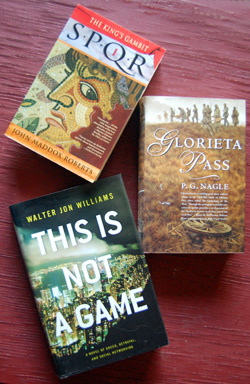
Nagle, Williams, Roberts
What do you think about asking a couple of writers why they made the choices they did?
ALAN: I think that’s an excellent idea.
JANE: Although there are many writers who work in more than one genre, I thought I could ask three I know fairly well, since they live here in New Mexico: Pati Nagle, Walter Jon Williams, and John Maddox Roberts.
Are you familiar with their works?
ALAN: I’m very familiar with Walter Jon Williams’ SF but I’ve never seen anything by him that wasn’t SF. I’ve read and greatly enjoyed John Maddox Roberts’ SPQR historical mysteries. I’ve only read one book by Pati Nagle, an excellent SF novel called Pet Noir about the adventures of Leon, a genetically modified cat. I also have a historical novel by her – it’s called Glorieta Pass. But I haven’t read it yet.
I suppose the obvious first question is, where did they all start? And what made them start there?
JANE: Let me ask them… Hang on!
Okay. I’m back. I found the answers quite interesting.
Most of our readership would be most familiar with Walter Jon Williams as a writer of SF, occasionally of Fantasy, but he actually started by publishing historical novels – although this was more by chance than otherwise.
Let me put it in Walter’s own words:
“That’s kind of a complex question, because I’ve been writing since I was a child. I wrote and submitted in practically all genres, but the first books to actually sell were historical fiction.
I didn’t set out to be a historical fiction writer, it was editors who decided that, by buying the Privateers & Gentlemen series. “
ALAN: I’ve never heard of that series. What are the books about?
JANE: They’re grand “Age of Sail,” I believe in the same time period as the Patrick O’Brien “Aubrey and Maturin” novels. After being out of print for a long time, they’re now available as e-books.
ALAN: That’s interesting. I love “Age of Sail” novels. (Alan does a google). Ah, here we are – all the novels are available as an ebook bundle from Baen books at a very reasonable price.
Clicketty-click. Click, click.
OK – I’ve bought them
JANE: That’s interesting. I didn’t realize they were available there. I’m sure they are on other platforms as well, for those who prefer them.
Now, John Maddox Roberts has also written SF/F, but he’s probably best known for his SPQR Roman mystery novels. Indeed, he’s been interested in writing historical novels all along, but his Rome was not his first choice.
Again, he explains the start of his writing career far better than I can:
“In 1973-74 my wife, Beth, and I were living in Scotland. I’d been planning to start writing seriously, so I borrowed a typewriter from our local baker and hammered out two books over a period of several months. The first was a straight historical novel, set during the Hundred Years’ War. It was a novel I’d been planning for some time but I was also an avid SF reader and had some ideas for a science fiction novel so I tackled that next. When we returned to Albuquerque in early 1975 I sent the sf novel to Doubleday because I’d been told they had a new sf editor who was looking for new talent. She bought it and I decided to concentrate on sf for the next few years. I’d sold my first novel to the first publisher I submitted it to and I was also told that wasn’t supposed to happen.”
ALAN: I first came across John Maddox Roberts with the SPQR novels and I absolutely loved them. But because of that, something in my head says that he is a historical novelist and therefore I have a deep reluctance to read his SF. Clearly this makes no sense, and I’m being stupidly biased. But nevertheless…
JANE: That is a problem for writers who write in more than one genre, and one reason that so many who do use more than one name.
Pati (who publishes as Pati Nagle, P.G. Nagle, and Patrice Greenwood) also was interested in multiple genres pretty much from the start.
As she says: “I’ve always made up stories about whatever caught my imagination, so it’s hard to identify a single genre. My first experiments in writing for publication were science fiction, followed by fantasy. My first short story sale was fantasy. My first novel sale was historical fiction.”
ALAN: It sounds like she has had a foot in every camp right from the very beginning. Good for her. How many feet has she got? (Don’t answer that!)
Could you ask them why they’ve ended up writing the kind of things that their names are (these days) most closely associated with?
JANE: I could indeed ask, but since I suspect their answers will be fulsome and thoughtful, and may lead to other questions, how about we chat about that next week?


March 2, 2016
Blank Pages
This past week, I acquired a new blank journal. I’d filled all my others (and one spiral notebook) when working on the mysterious “handwritten piece,” which I started back in mid-October, finished in mid-January, and have been typing up, revising, and suchlike since.

Dragon of Potential
I’m up to 30,000+ words and have quite a ways to go.
But that’s neither here nor there. As you can see from the attached picture, my new journal is very lovely . The cover was sculpted in polymer clay by my friend (and fellow writer) Emily Mah Tippets. It’s a solid little book, and I’m still debating what to put into it.
I don’t know how it is for most people in these days of computers, but blank paper has a lure for me that a blank computer screen does not. It seems like the incarnation of potential, which is rather ridiculous, since realistically it’s the reverse. After all, on a computer screen, you can immediately erase whatever you write or draw. When you write on paper, even with a pencil, the impact is much more permanent.
I don’t keep a diary (although I do keep a record of my writing). I keep a separate journal of what I’m reading. And I have a handmade book in which I occasionally record random thoughts.
What would you put in a blank journal?
This week’s installment is on the shorter side because I’m nursing a sore shoulder and keyboarding puts a stress on it.
Funny thing. Handwriting doesn’t cause me any pain at all, so, don’t worry… I’m still writing.


February 26, 2016
FF: Not As Much As I’d Like
For those of you just discovering this feature, the Friday Fragments lists what I’ve read over the past week. Most of the time I don’t include details of either short fiction (unless part of a book-length collection) or magazine articles.

Ogapoge Does Super Cute
The Fragments are not meant to be a recommendation list. If you’re interested in a not-at-all-inclusive recommendation list, you can look on my website under Neat Stuff.
Once again, this is not a book review column. It’s just a list with, maybe, a bit of description or a few opinions tossed in.
Recently Completed:
War of the Planet Burners by Dennis Herrick. A forthcoming small press novel.
Sammy Keyes and the Search for Snake Eyes by Wendelin Van Draanen. Middle-grade mystery.
In Progress:
The Prestige by Christopher Priest. Audiobook. Twisted and convoluted.
Reality Boy by A.S. King. Just started.
Also:
Various magazine articles.


February 25, 2016
TT: Into Mystery and Elsewhere
ALAN: I’ve noticed that when SF writers do stray outside their genre, they tend to write mystery stories of some kind. Both Jack Vance and Fredric Brown wrote award-winning mystery novels.
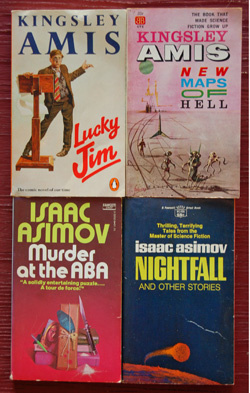
One Author, Various Flavors
JANE: Really? I had no idea. What were the titles?
ALAN: Jack Vance won an Edgar award for The Man in the Cage and Fredric Brown won an Edgar for The Fabulous Clipjoint.
Indeed, you could argue that Brown was more of a mystery writer than he was an SF writer. Certainly he was much more prolific in that genre. His bibliography on Wikipedia lists twenty-four mystery novels and only five SF novels…
And Isaac Asimov wrote some rather good classical mysteries as well.
JANE: Time to go check my bookshelves and see if I have either of those first two.
I’ve heard that about Asimov and I’ve read his Murder at the ABA. In 1975, when the book is set, the ABA was the largest convention for booksellers – and consequently attracted a lot of book publishers and writers as well. It still exists in a slightly different form as the BEA.
Anyhow, if you can get beyond the singularly most annoying first person narrator I’ve encountered in a long while, it’s not a bad mystery.
ALAN: It’s been years since I read it, so I don’t remember that. I just remember enjoying the mystery.
JANE: Above you said: “I’ve noticed that when SF writers do stray outside their genre, they tend to write mystery stories of some kind.”
To me this is fairly reasonable, since even when a story isn’t an obvious “whodunit,” much SF has a similar problem-solving ethic.
ALAN: I completely agree about the problem-solving ethic. That overlap is probably the reason why so many SF fans are also mystery fans. And vice-versa, of course.
In the UK, the genre boundaries have always tended to be a little more blurred than they are in America. H. G. Wells wrote across the spectrum and perhaps British writers have taken their inspiration from him.
Brian Aldiss has written several well-regarded mainstream literary novels. The Horatio Stubbs trilogy is particularly good in its depiction of youth caught up in war. And as a bonus, the first volume of the trilogy (The Hand Reared Boy) is the best novel about masturbation since Philip Roth’s Portnoy’s Complaint!
JANE: This last is a recommendation??? After I read Graham Joyce’s The Tooth Fairy, I felt grotty for weeks!
ALAN: Of course it’s a recommendation. The book will keep the average teenage boy enthralled and occupied for ages!
I also think you can make a good case for the majority of Christopher Priest’s books being SF-related mainstream novels as well, if that makes any sense. The Separation, for example, is set very firmly in the Second World War. They even made a movie from his novel The Prestige. It’s about feuding stage magicians…
JANE: I’ve heard about The Prestige, though I haven’t read it or seen the film. I’ve always meant to, since David Bowie played Tesla in it…
ALAN: Priest’s contemporary, J. G. Ballard cut his literary teeth in the SF world, but he soon left it far behind. I’m particularly fond of his semi-autobiographical novel Empire of the Sun about life in Shanghai under Japanese rule in the 1940s.
I don’t know if James Blish absorbed some of that influence or not, but around about the time he moved permanently to England, he wrote a stunningly brilliant historical novel (Dr. Mirabilis) about the life of Roger Bacon.
JANE: That last one sounds interesting. I’ve always been interested in Roger Bacon.
Certainly, there are American writers who have done/are doing the same. In fact, one could argue that there is a subset of “literary” writers who write SF/F, but because they were/are embraced by the literary community, they often get praised for doing what’s old hat in our field. A few examples…
Margaret Atwood regularly writes what is basically SF/F, but (so I’ve heard) doesn’t think she is doing so.
Michael Chabon’s Summerland was delightful, but certainly contained no surprises in terms of the material he used (a blending of myths, legends, and contemporary material) for anyone familiar with the works of Charles deLint, Neil Gaiman, Roger Zelazny, or, if I dare say so, Jane Lindskold.
Norman Mailer’s Harlot’s Ghost was published as mainstream fiction, but… Well, look at the title!
Some SF/F writers find this annoying. Maybe because I realize how under-read in genre fiction most “literary” critics (who often have academic backgrounds) are, I just sigh.
ALAN: Similarly, in Britain we have Doris Lessing, a Nobel Prize winning writer whose Canopus in Argos: Archives sequence are pure SF novels. I never liked them much, but they have their admirers. John Clute is particularly fond of them.
Lessing herself was an avowed SF fan. I used to see her sometimes in the SF bookshops of London, browsing the shelves and buying armfuls of lurid paperbacks, just like I was doing. She was a guest of honour at the Worldcon in 1987.
JANE: So it sounds as if Doris Lessing, bless her, wouldn’t mind being called an SF writer as well as a literary one. How refreshing! Someone who recognizes that it’s not an either/or sort of thing.
ALAN: She was proud of her SF work, and very happy to be thought of as an SF writer. Similarly, there is an up and coming British writer called David Mitchell who is winning lots of mainstream plaudits for novels such as The Cloud Atlas. Like Lessing before him, he seems to be quite impatient with genre boundaries and is more than happy to admit the influence of SF on his work.
Kingsley Amis was also a big SF fan. He published a very perceptive critical examination of the genre (New Maps of Hell) and in the 1960s, with Robert Conquest, he edited the Spectrum series of SF anthologies. He wrote several extremely good SF novels as well. The Alteration is an alternate history in which the Reformation never happened and the Catholic Church continues to dominate world affairs. Russian Hide and Seek is set in a future England that is a subject nation of the USSR. But my favourite is The Anti-Death League, a very odd novel indeed – conspiracy theorists will love it!
JANE: I’ve read – and enjoyed – New Maps of Hell. Oddly enough, although I really liked Amis’s Lucky Jim, I don’t think I’ve read any of the titles you mentioned above. Clearly I need to give some a try. I think that both The Alteration and The Anti-Death League sound interesting.
I’m assembling quite a list!
I also have an idea for next time… Here in New Mexico, we have quite a few writers who have been successful in more than one genre. Why don’t we ask them why they’ve branched out?


February 24, 2016
Action Figures!
Do you like action figures? Collect them? Did you play with them as a kid? If so, what sort appeals to you?
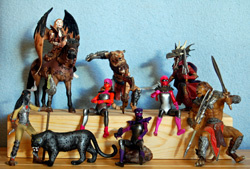
Getting into the Action
Lately, there’s been a lot of talk about action figures… And that’s gotten me thinking about action figures and their connection to stories.
Although I know some purists will differ, for the purposes of today’s Wander, I’m going to include figures that some might call “dolls” in the discussion. Since, according to Wikipedia, the term “action figure” was first coined by Hasbro for their G.I. Joe line, and the early G.I. Joes were clearly dolls, just dolls meant for boys rather than girls, I think I’m on safe ground. And, of course, figures of this sort pre-date Hasbro coining the term. “Tin soldiers” filled the need long before plastics came along. They were followed by any number of rubber and plastic figures.
As I see it, there are three general classes into which action figures fall: figures that are essentially illustrations of a specific character from comics, television, or movies; figures with some story, and figures without a backstory .
Dolls tied to specific television and movie characters go back a long way. Their shapes have changed along with affordable materials, until today you may purchase a highly poseable representation of the character of your choice, complete with characteristic equipment. Although still marketed to children, many adults collect these as well. Indeed, there is a sub-market of high-priced figures meant for adults.
When I asked on Twitter why people collect action figures, Jas. Marshall replied: “As a talisman w/the traits of the character. Ex: I have a River Song figure from the ep where she made a Dalek beg for mercy.”
Jas. Marshall is in good company here. The attachment to figures of potent characters as talismans probably began back in prehistory. Often these would have been figures of gods or demigods but if, as Christopher Knowles persuasively argues in his book of the same title “our gods wear spandex,” then these action figures are part of a venerable tradition.
Figures with some story have also been around for a long time. Barbie started out as a fashion doll, basically, a miniature model which girls could costume as they chose. However, over time, Barbie acquired a sister (Skipper), a boyfriend (Ken), and various friends. Even when I was a girl (a long, long time ago) there were books telling about their interactions. These stories weren’t very detailed. The one I remember had to do with what Barbie was going to wear to a picnic; the kicker was that after spending page after page trying on different outfits, Barbie arrives at the picnic to find that everyone is wearing the same dress. Nonetheless, these slim books did give a sense of potential stories involving Barbie and her friends.
Today, of course, Barbie has moved into the class of figure with a full and detailed backstory, which is presented in movies, books, and comics. She has a great deal of company in this.
One of the most fascinating evolutions related to action figures and story is the “Ever After High” line of dolls/action figures. These dolls are supposed to be the descendants of various fairytale characters. Some are happy to follow the tradition set by their parents. Others want to break the mold and make their own stories.
Author Shannon Hale tells on her website how she (an already established author of YA and middle grade fiction) was approached to write the backstories for these characters, up to and including novels. What’s fascinating about this to me is that these were dolls that hadn’t yet been released. Other than alluding to traditional fairytales, they were not tie-ins to any existing story. However, having a story in place was clearly meant to make them more compelling.
That’s rather cool. I plan to read the first book in the series, because I want to find out more.
Providing a toy with a backstory is not unique, certainly. However, a more common mechanism for getting the story out has been a cartoon series (Jem; He-Man and the Masters of the Universe) as the marketing tool of choice, not the old-fashioned, so often maligned book.
However, despite the mechanism being in place for promoting action figures as part of an existing story, there are plenty of figures that are provided with only the thinnest of stories: sometimes only a name and a few lines of text. Some of the figures in today’s picture fall into that category. The animal-warrior figures are from Papo and are listed in their catalog simply as “Mutant Lion” and “Mutant Tiger.” Who mutated them, why they were mutated, and whether they are unique or part of a larger culture is left to the imagination of the owner.
The producers of the I Am Elemental figures go out of their way not to provide a backstory for their characters, even though in other ways these masked figures greatly resemble higher-end superhero action figures (which are usually tied to some comic franchise or other). I Am Elemental’s website makes clear they are prompting a “play experience where girls are the creators of their own stories.”
Obviously, I have action figures, including the ones in the illustration. Although I don’t have any that I’ve purchased because of their association with a favorite series or movie, I do own a couple. For example, I have a blue-haired anime figure that Jim bought me, not because she was the heroine of Sakura Wars (which I’ve never seen), but because, at that time, the character I was playing in a friend’s RPG happened to have blue hair. So, my figure is named Yunome Ame, not Sakura.
And, believe me, if I saw the right figure from a favorite show, I wouldn’t hesitate to join Jas. Marshall in giving it shelf-space as a talisman.
That said, most of my figures have been purchased because of a sense that there’s a story there. In some cases, the story has been written. The pale-featured young woman on the horse in today’s illustration would become Blackrose in my short story “Hunting the Unicorn.” A certain two-headed dragon given as a gift by a college friend would become Betwixt and Between in my first published novel Brother to Dragons, Companion to Owls.
I rather like to think that someday I’ll find the right story to go with the Mutant Tiger and Mutant Lion.
So… Do you like action figures? Collect them? Did you play with them as a kid? If so, what sort appeals to you? Have any of them ever given you a story?


February 19, 2016
FF: As Worlds Evolve
This week I continued several series, which made me think some about the form.

Kel Does Her Supermodel Thing
For those of you just discovering this feature, the Friday Fragments lists what I’ve read over the past week. Most of the time I don’t include details of either short fiction (unless part of a book-length collection) or magazine articles.
The Fragments are not meant to be a recommendation list. If you’re interested in a not-at-all-inclusive recommendation list, you can look on my website under Neat Stuff.
Once again, this is not a book review column. It’s just a list with, maybe, a bit of description or a few opinions tossed in.
Recently Completed:
Seeds of Rebellion (Beyonders 2) by Brandon Mull. Suffers from “middle book of a trilogy” syndrome. Additionally, inclusion of a larger number of adult characters mean that our teen protagonists begin to seem like “extras.” Given the number of times both Rachel and Jason muse if they’ve fulfilled the role for which they were summoned to this fantasy world, I wonder if the author was subconsciously wondering the same thing.
The Adventures of Sherlock Holmes by Arthur Conan Doyle. Audiobook. Enjoyed all over again.
Kitty’s Big Trouble by Carrie Vaughn. Audiobook. Despite the title, much less dramatic than the last couple in the series. Chinese material expanded the “universe.” The inclusion of film as inspiration/source material appropriate for this series, which (like much of the “paranormal urban fantasy” sub-genre) seems more based out of movies than folklore.
In Progress:
The Prestige by Christopher Priest. Audiobook. Just started.
War of the Planet Burners by Dennis Herrick. A forthcoming small press novel.
Also:
Quite a bit of scattered short material.


February 18, 2016
TT: Crossing the Border
ALAN: We were talking about writing outside of your genre comfort zone. I remember being very impressed with your novel The Buried Pyramid. The fantasy elements don’t kick in until about half way through the book, and the first half is a grittily real bit of historical scene-setting. It seems to me that the book could easily have grown up to be a proper historical novel if you’d decided to take it that way. Have you ever considered writing non-SF/F novels?
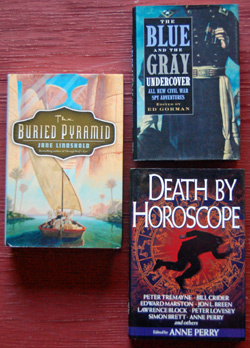
In and Out of Genre
JANE: Not really. I guess I have a weird brain, but what interests me are stories that incorporate “speculative” aspects as part of the normal world – much as I do in The Buried Pyramid. It just seems more natural.
ALAN: I’m not sure I really understand what you mean by that. Can you give me an example?
JANE: Well, to the ancient Egyptians, their gods were part of their day-to-day existence, not reserved for “temple” or whatever. So, it seemed natural to me that at some point in the course of the events detailed in The Buried Pyramid the gods would decide to join in.
Another good example are my short stories with Prudence Bledsloe. The stories are historically accurate to the post-Civil War American West – the so-called “Wild West.” For the story I finished a few weeks ago – “Choice of Weapons” – I spent a huge amount of time checking historical dates to make certain that the elements I wanted would have been possible within the historical context.
However, Prudence is a werewolf. I was actually surprised when a friend mentioned that her husband considered this an odd thing. To me it’s completely natural.
ALAN: Me, too, in the sense that it doesn’t take me by surprise when something like that happens. I suspect most SF fans would feel the same way. It’s a sure sign of a misspent youth – being indoctrinated with the SF/F point of view on the way the world works in your formative reading years often means that you start to expect this kind of thing to happen. Indeed, there can be a vague feeling of disappointment when you read stories in other genres and there aren’t any werewolves (or whatever) in them.
JANE: I agree! What’s odd is that my friend’s husband does read SF. He’s a big fan of Neil Stephenson, who I think you also like.
ALAN: True – but I think Stephenson’s best novels (Crypotonomicon and The Baroque Cycle for example) are the ones that are closer to historical fiction than they are to science fiction. Which is what this tangent is all about, of course!
JANE: Funny, I’d never thought of it that way, but Cryptonomicon is definitely historical fiction with a twist.
Anyhow, to continue answering your question, if I’m writing science fiction, I prefer to include aliens or other weirdness. I’m not interested in a potential future that is just more of us doing more of the same things except somewhere else.
I have written a couple of non-SF/F short stories, though.
ALAN: What? Proper stories? No SF/F elements at all? Tell me about them.
JANE: Both came about because of invitations to write for theme anthologies. Oddly, both were published in 2001. Some fifteen years later, I really can’t remember which I wrote first.
One was for an anthology of murder mystery stories edited by Anne Perry, with the assistance of John Helfers of Tekno Books. For those who don’t remember, Tekno Books was the company run by Martin H. Greenberg and which, whether acknowledged on the book or not, probably had something to do the majority of anthologies published in the 1980’s (when I started being aware of publishers; Marty was working in the field even earlier) through 2011 when he died of cancer.
I mention this because I never had any contact with Anne Perry, only with John.
ALAN: You know I’ve always found it ironic that Anne Perry, who is a convicted murderer, makes her living writing murder mysteries. Of course, you could say that she is obeying the dictum to “write what you know,” so actually it isn’t ironic at all!
JANE: Ouch! Anyhow, I can’t remember if John contacted me by e-mail or phone, but I think it was phone because I recall an exchange something like this.
JOHN: Jane, I know you usually write SF/F, but would you like to do a straight mystery story?
JANE: Absolutely! I love mysteries. Other than SF/F, it’s probably the genre I read the most.
JOHN: Well, this is for a theme anthology where all the mysteries need to be somehow tied to the horoscope. Knowing how you love myth and folklore and such, I thought it would be right up your alley.
JANE: That does sound cool, but you must be getting a lot of serial killer stories.
JOHN: (long pause) No, I don’t think we have any.
JANE: Okay! I’ll do one.
And I did. It was called “Slaying the Serpent,” and appeared in Death by Horoscope. I did a lot of research not only into the horoscope, but into forensics, profiling, and typical serial killer behavior… At least of the more flamboyant type.
ALAN: Why on Earth (or off it) did you immediately think of serial killers? Is that your secret superpower?
JANE: Oh, there was a notorious serial killer who was dubbed “The Zodiac Killer.” He was active in the 1960’s and 1970’s, I believe. Seemed perfectly logical to me that everyone would recall him.
The other “proper” story I wrote was a historical, for a collection of Civil War spy stories edited by Ed Gorman, titled The Blue and Gray Undercover. I’d lived in Virginia for about five years and wanted to set my story in terrain I knew well.
A man named Jed Hotchkiss quickly caught my fancy. He was a cartographer, the first person to map the Shenandoah Valley in Virginia. His maps were considered key to Confederate victories in that area, especially that of Stonewall Jackson at Stony Creek.
Obviously, in wartime, a cartographer can’t work openly, so Hotchkiss and his associates qualified as spies. The techniques they used to cover that they were actually collecting data were fascinating.
ALAN: Robert Baden-Powell, the founder of the Boy Scout movement, made maps of enemy fortifications and highlighted the positions of their heavy artillery. He concealed the maps in sketches of butterflies; the maps were presented as elaborate markings on their wings…
JANE: Oh! That’s really cool. I had no idea!
Suffice to say, I really enjoyed both the historical research and then finding a way to tell a story that would be more heart-gripping than a mere info dump. The story is called “The Road to Stony Creek,” by the way.
ALAN: I wonder how other writers feel about this kind of thing? Let’s explore it more next time.







